








Edwin Willard Deming (American, 1860-1942)
Mutual Surprise, 1907
Bronze, brown patina
9 ⅜ H. x 8 W. x 4 ¼ D. inches
Signed on base: Copyright / 1907 / By: E W DEMING
Inscribed: ROMAN BRONZE WORKS N-Y-
Bears were a favorite subject for Deming and they figured often in his sculpture. He had been dubbed “Eight Bears” by his Blackfoot Indian acquaintances, occasioning him to name his New York studio in MacDougal Alley the Lodge of the Eight Bears. “Mutual Surprise”, 1907 depicts an unexpected humorous moment in this wildlife encounter between two creatures. The looming stance of the awkward bear cub and the questioning pose of the open-mouthed snapping turtle. Castings of Mutual Surprise are in the collections of the Metropolitan Museum of Art, the R.W. Norton Art Gallery and the National Wildlife Art Museum.


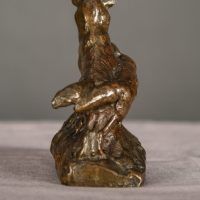



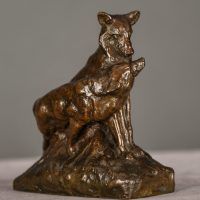
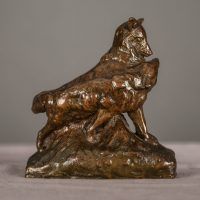
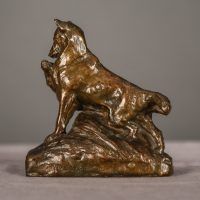
Edwin Willard Deming (American, 1860-1942)
Prairie Courtship, 1910
Bronze, 5 7/8 H. x 5 3/8 W. x 3 7/8 D. inches
Dark brown patina
Signed on base: 1910 E.W. Deming
Stamped on base: R.B.W.

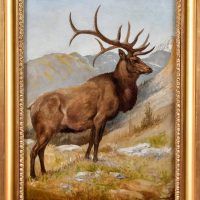
Edwin Willard Deming (American, 1860-1942)
Monarch of the Rockies, 1917
Oil on canvas, 18 H. x 13 W. inches
Edwin Willard Deming (1860-1942) grew up on a former tract of Indian reservation land in Geneseo, Illinois. His youthful observations of Native American life, formed the basis of his work, painting, sculpture, illustrations and writings. He studied at the Art Students League in New York and the Academie Julian in Paris, returning to the United States in 1885.
Deming quickly established a pattern that he maintained throughout his career: he traveled west to Indian lands in the summers, returning to his studio in New York with sketches, photographs and notes that he translated into paintings and sculptures during the winters. Among his expeditions were visits to the Apache and Pueblo tribes of the Southwest and the Umatillas of Oregon in 1887 and the Crow in Montana and Wyoming. Deming became an honorary member of the Blackfoot tribe in 1898.
Deming used his talents to depict accurately vanishing tribal customs and beliefs. His most ambitious effort was the set of murals (1914-1916) depicting the principal Indian nations at the entrance of the Plains Indian Hall at the American Museum of Natural History, New York.
Reference: Thayer Tolles, American Sculpture in The Metropolitan Museum of Art, Volume I. 1999.